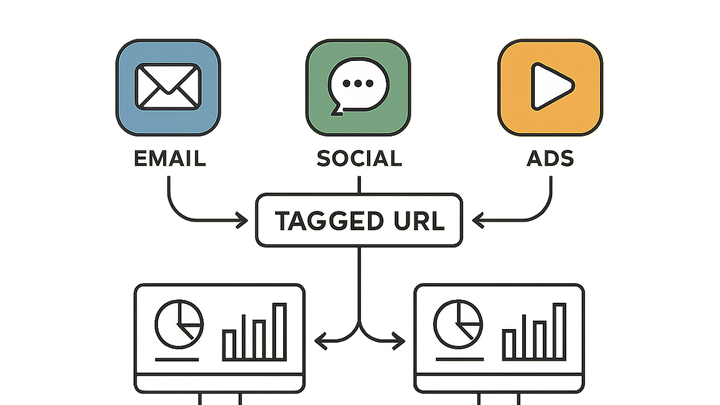Published on 2025-06-22T02:10:12Z
What is Campaign Tracking? Examples of Campaign Tracking
Campaign Tracking is the process of tagging and monitoring marketing campaigns across digital channels to measure performance and ROI. By appending UTM parameters to URLs and using analytics platforms like GA4 and PlainSignal, marketers can attribute website visits, conversions, and other engagement metrics to specific campaigns. This visibility helps teams optimize marketing spend, tailor messaging, and make data-driven decisions. Modern analytics tools such as Google Analytics 4 (GA4) offer built-in support for tracking parameters, while privacy-focused solutions like PlainSignal enable cookie-free tracking with minimal setup. Whether you’re launching an email blast, paid search campaign, or social media promotion, campaign tracking ensures you know exactly which efforts are driving results.
Campaign tracking
Tagging and monitoring digital marketing campaigns using UTM parameters in analytics platforms like GA4 and PlainSignal.
Why Campaign Tracking Matters
Campaign tracking provides marketers with clear insights into which marketing efforts drive traffic, engagement, and conversions. It transforms raw visitor data into actionable intelligence, enabling teams to allocate budget efficiently and improve ROI.
-
Data-driven insights
Tracking each campaign allows you to see exactly which channels and tactics are performing best, replacing guesswork with solid data.
-
Identify top channels
Determine which sources (e.g., email, social, paid ads) deliver the most traffic and engagement.
-
Optimize budgets
Redirect spend toward high-performing campaigns while pausing underperforming ones.
-
-
Accurate roi measurement
By tying conversions and revenue back to specific campaigns, marketers can calculate true return on investment.
Key Components of Campaign Tracking
Effective campaign tracking relies on a few core elements that work together to capture and report campaign performance.
-
Utm parameters
Standardized query parameters appended to URLs, such as utm_source, utm_medium, utm_campaign, that tell analytics tools where traffic originates.
-
Utm_source
Identifies the referrer (e.g., ‘newsletter’, ‘facebook’).
-
Utm_medium
Specifies the marketing medium (e.g., ‘email’, ‘cpc’).
-
Utm_campaign
Names the specific campaign or promotion.
-
-
Tracking scripts and tags
JavaScript snippets in your site’s code that send data to analytics platforms whenever a user visits with UTM parameters.
-
GA4 gtag.js
Google’s global site tag for capturing events and pageviews in Google Analytics 4.
-
PlainSignal script
A lightweight, cookie-free analytics script that can capture campaign data.
-
-
Campaign url builders
Tools that help generate properly formatted URLs with UTM parameters, reducing human error.
Implementing Campaign Tracking
Step-by-step setup for tracking campaigns in both Google Analytics 4 and PlainSignal, with code examples and verification tips.
-
Setting up in GA4
- Use Google’s Campaign URL Builder or manually add UTM parameters to your links.
- Ensure your site includes the GA4 gtag.js snippet or via Google Tag Manager.
- Verify campaign traffic in the Acquisition > Campaigns report.
-
Add the GA4 tag
Include the following in your <head>:
<!-- Google Analytics 4 --> <script async src="https://www.googletagmanager.com/gtag/js?id=G-XXXXXXX"></script> <script> window.dataLayer = window.dataLayer || []; function gtag(){dataLayer.push(arguments);} gtag('js', new Date()); gtag('config', 'G-XXXXXXX'); </script> -
Build campaign urls
Use UTM parameters consistently (e.g., utm_source=newsletter, utm_medium=email).
-
Setting up in PlainSignal
- Add the PlainSignal script to your site.
- Append UTM parameters to your campaign URLs.
- Check the PlainSignal dashboard for campaign metrics.
-
Add the PlainSignal script
Insert this into your <head>:
<link rel="preconnect" href="//eu.plainsignal.com/" crossorigin /> <script defer data-do="yourwebsitedomain.com" data-id="0GQV1xmtzQQ" data-api="//eu.plainsignal.com" src="//cdn.plainsignal.com/plainsignal-min.js"></script> -
Tag your links
Append UTM parameters just like in GA4 to ensure PlainSignal captures campaign info.
-
Verify in dashboard
Navigate to the campaigns report in PlainSignal to see traffic and conversion metrics.
Best Practices and Common Pitfalls
Maintaining accurate and reliable campaign data requires attention to detail and adherence to best practices.
-
Maintain consistent naming
Stick to a pre-defined format for UTM parameters to prevent fragmented data in reports.
-
Create a naming guide
Document and share your utm_source, utm_medium, and utm_campaign conventions with the team.
-
-
Avoid parameter conflicts
Ensure that UTM parameters aren’t stripped or overridden by other scripts or redirects.
-
Check redirects
Test all campaign URLs through your site’s redirect chain to confirm parameters persist.
-
-
Respect user privacy
Comply with privacy regulations and consider cookie-free solutions for users who opt out of tracking.
-
Cookie-free tracking
Leverage PlainSignal’s approach to avoid reliance on cookies while still capturing key campaign data.
-
